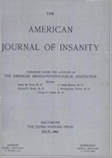Abstract
A statistical study of delusions in 1009 cases of manic-depressive psychoses, with 1408 cases of schizophrenia and 496 cases of general paresis as controls leads to the following conclusions: delusions are absent in 43 per cent of the males and 41 per cent of the females in the manic-depressive group as compared with 10 per cent of the males and 7 per cent of the females in schizophrenia, and 39 per cent of the males and 42 per cent of the females in general paresis. The most common type of delusion to occur in the manic-depressive psychoses is the persecutory type which was present in 20 per cent of cases of manic-depressive psychoses. Persecutory delusions were likewise the most common delusion to occur in schizophrenia, there being 54 per cent of the males and 58 per cent of the females having such delusions. The incidence of persecutory delusions in general paresis was practically the same as in the manic-depressive psychoses, but males showed 27 per cent and females 12 per cent of grandiose delusions indicating that grandiose delusions are the most common type to occur in general paresis. The schizophrenic group shows a consistently higher percentage of religious and erotic delusions than do the manic-depressive group whereas the grandiose and hypochondriacal delusions show no significant differences.
In an endeavor to determine what other factors besides diagnosis and sex might determine the presence of delusions or the type of delusions detailed two-way association tables were made for each sex and diagnosis showing the relationship between delusions and each of the following conditions: (1) Marital condition; (2) Age at admission; (3) Birthplace of patient; (4) Religion; (5) Personality traits; (6) Intelligence; (7) Somatic data; (8) Hallucinations; (9) Duration of attack previous to admission; (10) Previous attacks; (11) Alcoholic habits; (12) White blood count.
Marital condition apparently has little to do with the type of delusion, the only things noted being that among the single females with manic-depressive psychoses persecutory delusions were fewer than would be expected, and in married females with schizophrenia fewer erotic delusions occurred than would be expected.
Age shows nothing of significance for the manic-depressive and general paretic groups, but does show that in persons with schizo-phrenia delusions are less frequent among younger persons.
The birthplace of the patient shows no important effect upon the incidence or type of delusion for all three groups.
Religion apparently has very little influence on the occurrence of delusions. It was noted however that Hebrew males in the general paretic group showed an excess of grandiose delusions.
The pre-psychotic personality of the patient seemed to show several significant associations with the number and types of delusions. In general these associations show no consistent pattern except that in the schizophrenic group the sexually unbalanced personalities correlated with a number of different types of delusions.
Intelligence seems to have some relationship to numbers and types of delusions. In the manic-depressive group there are more cases of superior intelligence with no delusions than would be expected. This tendency is not found in schizophrenia where in the females the cases of borderline intelligence show a correlation with no delusions. The general paretic group shows nothing of significance.
There is little correlation between delusions and somatic data, the only significant finding being that there are more manic-depressive females with no delusions and negative somatic data than would be expected.
There is considerable correlation between delusions and halluci-nations. In all three groups there is a positive association between no delusions and no hallucinations and between unknown delusions and unknown hallucinations. The most striking correlation is between persecutory delusions and auditory hallucinations which show a positive association in all groups except schizophrenic females.
The duration of attack previous to admission has very little effect on the delusional formation of the patient, the only significant finding being fewer hypochondriacal delusions in manic-depressive females where the attack is under 31 days, and excess of hypochondriacal delusions where the attack has been from 1-11 months.
The occurrence of a previous attack seems to have no important effect upon the number of types of delusions for all three types of mental disorder.
With regard to alcoholic habits the only important findings seem to be that no delusions occur more frequently in schizophrenic and general paretic males who are abstinent and in schizophrenic males who are temperate.
There is no significant association between the white blood count and delusions.

